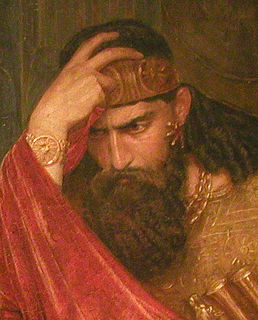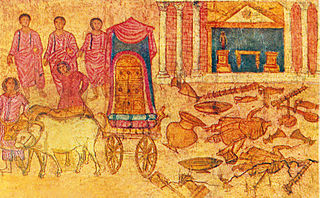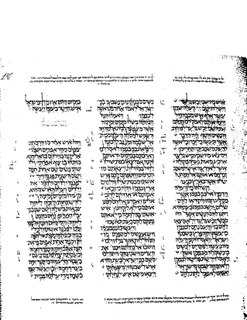Related Research Articles

The Book of Samuel is a book in the Hebrew Bible, found as two books in the Christian Old Testament. The book is part of the narrative history of Ancient Israel called the Deuteronomistic history, a series of books that constitute a theological history of the Israelites and that aim to explain God's law for Israel under the guidance of the prophets.

David is described in the Hebrew Bible as the third king of the United Monarchy of Israel and Judah. In the Books of Samuel, David is a young shepherd and harpist who gains fame by slaying the giant Goliath, a champion of the Philistines in southern Canaan. David becomes a favorite of the first king of united Israel, Saul, and forges a close friendship with Jonathan, a son of Saul. Paranoid that David is seeking to usurp the throne, Saul attempts to kill David, forcing the latter to go into hiding and operate as a fugitive for several years. After Saul and Jonathan are both killed in battle against the Philistines, a 30-year-old David is anointed king over all of Israel and Judah, following which he conquers the city of Jerusalem, establishes it as Israel's capital, and takes the Ark of the Covenant into the city to be the centre-point of worship in the Israelite religion.

The Philistines were an ancient people who lived on the south coast of Canaan from the 12th century BC until 604 BC, when their polity, after having already been subjugated for centuries by the Neo-Assyrian Empire, was finally destroyed by King Nebuchadnezzar II of the Neo-Babylonian Empire. After becoming part of his empire and its successor, the Persian Empire, they lost their distinct ethnic identity and disappeared from the historical and archaeological record by the late 5th century BC. The Philistines are known for their biblical conflict with the Israelites. Though the primary source of information about the Philistines is the Hebrew Bible, they are first attested to in reliefs at the Temple of Ramses III at Medinet Habu, in which they are called Peleset ; the parallel Assyrian term is Palastu, Pilišti, or Pilistu.

Saul, according to the Hebrew Bible, was the first monarch of the United Kingdom of Israel. His reign, traditionally placed in the late 11th century BCE, supposedly marked the transition of Israel and Judah from a scattered tribal society to organized statehood.

Samuel is a figure who, in the narratives of the Hebrew Bible, plays a key role in the transition from the period of the biblical judges to the institution of a kingdom under Saul, and again in the transition from Saul to David. He is venerated as a prophet by Jews, Christians, and Muslims. In addition to his role in the Hebrew Scriptures, Samuel is mentioned in the New Testament, in rabbinical literature, and in the second chapter of the Qur'an. He is also treated in the fifth through seventh books of Josephus's Antiquities of the Jews, written in the first century CE (AD). He is first called the Seer in 1 Samuel 9:9.

Goliath is a character in the biblical Book of Samuel, described as a Philistine giant defeated by the young David in single combat. The story signified Saul's unfitness to rule, as Saul himself should have fought for Israel. Scholars today believe that the original listed killer of Goliath was Elhanan, son of Jair, and that the authors of the Deuteronomic history changed the original text to credit the victory to the more famous character David.
Ziklag is the biblical name of a town that was located in the Negev region in the south-west of what was the Kingdom of Judah. It was a provincial town within the Philistine kingdom of Gath when Achish was king. Its exact location has not been identified with any certainty.
Obed-Edom is a biblical name which in Hebrew means "servant of Edom," and which appears in the books of 2 Samuel and 1 and 2 Chronicles. The relationship between these passages has been the subject of scholarly discussions which express uncertainty and disagreements about the relationships between various passages that use the name.

Philistia, also known as the Philistine Pentapolis, was a confederation of cities in the Southwest Levant, which included the cities of Ashdod, Ashkelon, Ekron, Gath, Gaza, and for a time, Jaffa. It was populated by the Peleset, or Philistines, who are believed to have been an Indo-European people who settled in Canaan around the year 1200 BC; they had particular resemblances to the Mycenaean civilization. At its maximum territorial expansion, its territory may have stretched along the Canaanite coast from Arish in the Sinai to the Yarkon River, and as far inland as Ekron and Gath. Nebuchadnezzar II invaded Philistia in 604 BC, burned Ashkelon, and incorporated the territory in the Neo-Babylonian Empire; Philistia and its native population the Philistines disappear from the historic record after that year.
Shammah is a name mentioned several times in the Hebrew Bible.

David's Mighty Warriors are a group of 37 men in the Hebrew Bible who fought with King David and are identified in 2 Samuel 23:8–38, part of the "supplementary information" added to the Second Book of Samuel in its final four chapters. The International Standard Version calls them "David's special forces".
In the Bible, the Cherethites and Pelethites, the former also spelled Kerethites, are two ethnic groups in the Levant. Their identity has not been determined with certainty. The Cherethites are mentioned independently three times, and as the "Cherethites and Pelethites" seven times. They are interpreted to have been a group of elite mercenaries employed by King David, some of whom acted as his bodyguards, and others as part of his army.
Elhanan, son of Jaare-Oregim the Bethlehemite is a character in 2 Samuel 21:19, where he is credited with killing Goliath: "There was another battle with the Philistines at Gob, and Elhanan son of Jaare-oregim the Bethlehemite killed Goliath the Gittite, the shaft of whose spear was like a weaver's beam.".

The Philistine captivity of the Ark was an episode described in the biblical history of the Israelites, in which the Ark of the covenant was in the possession of the Philistines, who had captured it after defeating the Israelites in a battle at a location between Eben-ezer, where the Israelites encamped, and Aphek, where the Philistines encamped.
Eleazar was one of the Three Mighty Warriors and an officer under David, according to 2 Samuel and 1 Chronicles. His father was Dodai or Dodo, and he was a Benjamite through his ancestor Ahoah.

David and Goliath is a 1960 Italian film directed by Ferdinando Baldi and Richard Pottier with sequences filmed in Israel and Yugoslavia.
Jashobeam, also called Josheb-Basshebeth and possibly Adino the Eznite, was chief of the Three Mighty Warriors, and an officer appointed under King David in charge of the first division of 24,000 men, on duty for the first month of the year, according to the list given in 1 Chronicles 27. Jashobeam was a Benjamite from Hakmon. His father was Zabdiel, a descendant of Korah. He was also a descendant of Pharez of the Tribe of Judah.

1 Samuel 5 is the fifth chapter of the First Book of Samuel in the Old Testament of the Christian Bible or the first part of the Books of Samuel in the Hebrew Bible. According to Jewish tradition the book was attributed to the prophet Samuel, with additions by the prophets Gad and Nathan, but modern scholars view it as a composition of a number of independent texts of various ages from c. 630–540 BCE. This chapter describes how the Ark of Covenant was taken by the Philistines, a part of the "Ark Narrative" within a section concerning the life of Samuel.

1 Samuel 17 is the seventeenth chapter of the First Book of Samuel in the Old Testament of the Christian Bible or the first part of the Books of Samuel in the Hebrew Bible. According to Jewish tradition the book was attributed to the prophet Samuel, with additions by the prophets Gad and Nathan, but modern scholars view it as a composition of a number of independent texts of various ages from c. 630–540 BCE. This chapter contains the battle of David with Goliath, the Philistine. This is within a section comprising 1 Samuel 16 to 2 Samuel 5 which records the rise of David as the king of Israel.

1 Samuel 7 is the seventh chapter of the First Book of Samuel in the Old Testament of the Christian Bible or the first part of the Books of Samuel in the Hebrew Bible. According to Jewish tradition the book was attributed to the prophet Samuel, with additions by the prophets Gad and Nathan, but modern scholars view it as a composition of a number of independent texts of various ages from c. 630–540 BCE. This chapter records a victory of Israel under the leadership of Samuel against the Philistines as part of the "Ark Narrative" within a section concerning the life of Samuel, and also as part of a section comprising 1 Samuel 7–15 which records the rise of the monarchy in Israel and the account of the first years of King Saul.
References
- ↑ David Toshio Tsumura (15 March 2007). The First Book of Samuel. Wm. B. Eerdmans Publishing. p. 438. ISBN 978-0-8028-2359-5.